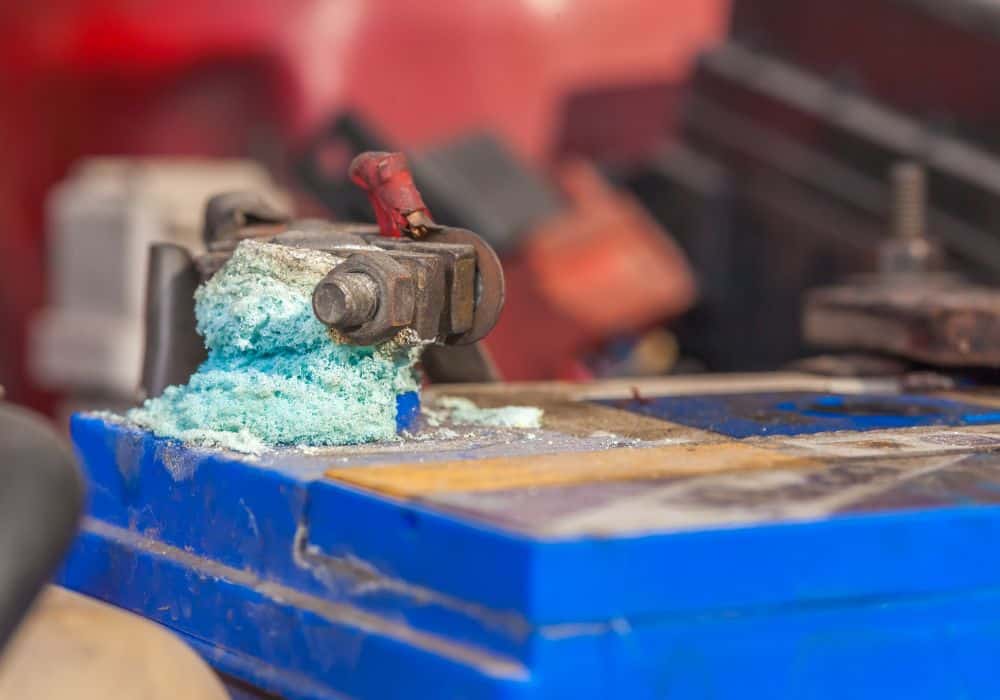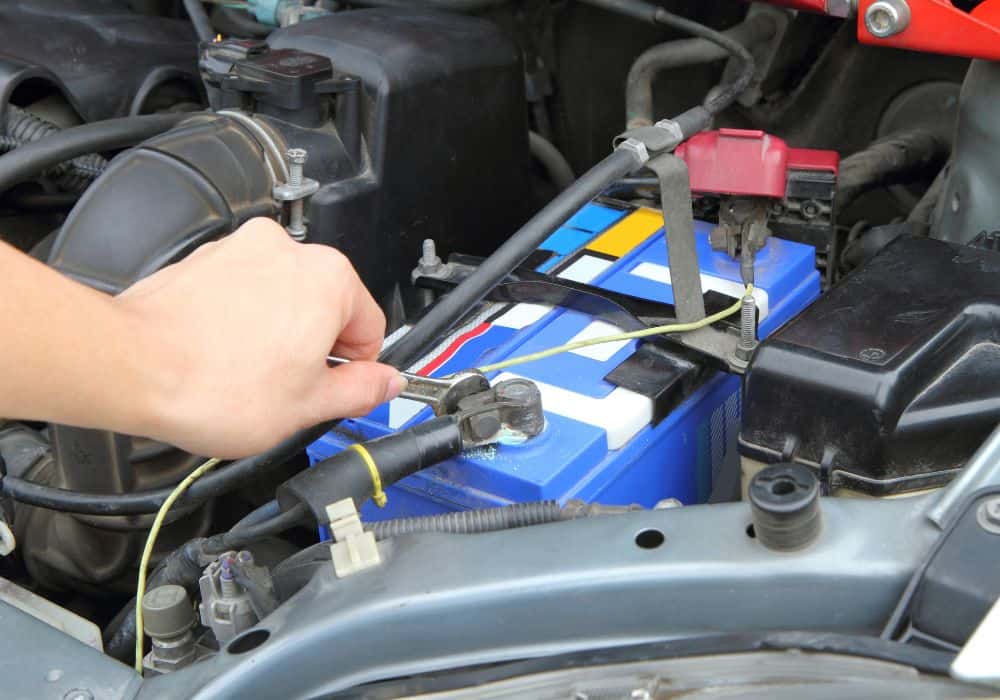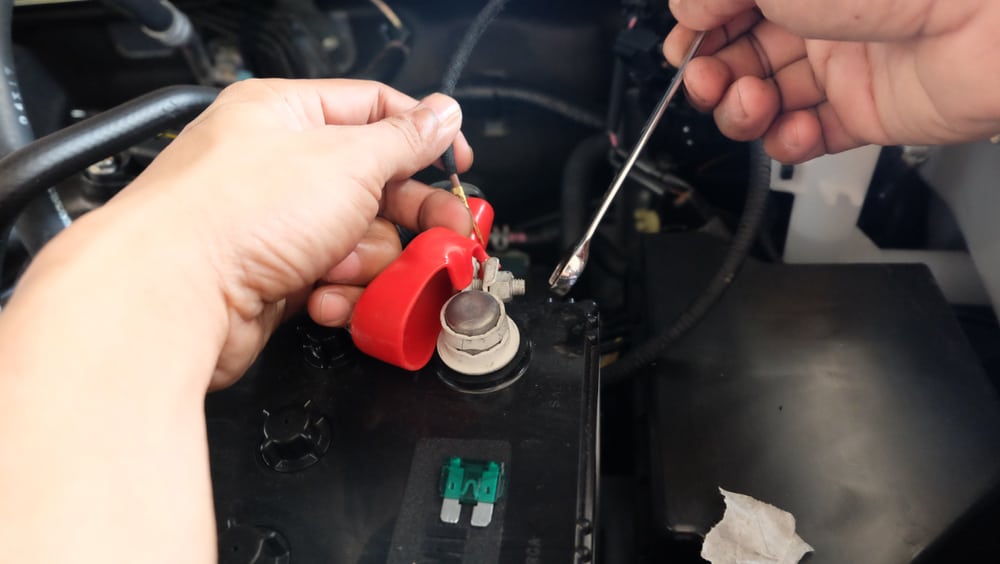Proper car battery maintenance is a complicated but important process that doesn’t just include looking under your car’s hood every once in a while, however – it also means cleaning the battery when necessary, removing corrosion, changing cables or tie-downs, and so on.
When talking about cleaning, specifically, the first thing most people mention is baking soda. And that does work well for cleaning a car battery’s terminals, however, many people are not comfortable with baking soda and prefer to look for different solutions whenever possible. So, here’s our step-by-step guide for how to clean battery terminals without baking soda.
Table of Contents
Vinegar – the answer to how to clean battery terminals without baking soda
There are quite a few alternatives to baking soda when battling a corroded battery and we’ll mention some other big ones below. But vinegar is our preferred choice for this particular task as it’s easy and safe to use while also being very effective. Plus, it’s even easier to find in most people’s households than baking soda.
What to prepare?
As with any other time you pop the hood of your car open, it’s best to have all the tools you’re going to need on hand before you even start. The fewer times you have to run to the store for a single item, the faster and easier the whole process is going to be. So, here’s what you’d want to prepare:
- A rag or two or any disposable piece of cloth to insulate the battery cables
- An extra rag piece or two
- Rubber gloves and protective gloves
- Vinegar (ideally white vinegar) or a different cleaning solution of the ones we’ll list further below
- A medium-sized container or bottle for the vinegar
As you can see, cleaning your car battery’s terminals doesn’t really include a lot of overly expensive components and supplies. So, the more crucial step is how you use them, so, let’s go over that next.
A step-by-step guide for how to clean battery terminals without baking soda but with vinegar instead:

Step 1: Put on the right protective gear
Goggles and gloves are a must every time we fiddle with high-power devices such as a car battery yet many of us ignore that first step. Yes, ideally, there will be no danger but it’s always better to be safe than sorry.
Step 2: Turn off the engine
Whatever you do under your car’s roof and on and around the car battery, you want the engine to be off. Even with protective gear, you can get in a nasty accident if you try playing with your car battery’s terminals while the engine is still on.
Step 3: Check the condition of the battery
Now that you’re ready to get touchy, take a good look at the battery and its surrounding area. Is there any warping, bulging, bloating, or cracking on or around the battery? Do you notice a battery acid leak or some residue near the terminals or clamps?
If you’ve got a major battery leak or bloating rather than just a minor corroded area you may not need to bother cleaning the battery – you’ll need to just replace it with a new one instead. If you do only need to deal with your car’s battery corrosion, however, let’s proceed with the next step.
Step 4: Disconnect the cables from the battery’s terminals, insulate them, and set them aside
When disconnecting a car battery, it’s important to always with the negative clamp first and only then remove the positive clamp.
Usually, the negative (grounding) cable will be black and the positive cable will be red. It is a good idea to consult with your car’s manual first if you’re not sure if that’s the case with your vehicle, however.
Regardless, you want to disconnect both the negative and positive terminals before you start cleaning.

Do remember to insulate the battery’s cables with pieces of cloth before you start cleaning the terminals, however, as well as to avoid any direct contact between the cables and any metal items. This is crucial if you want to avoid an accidental short-circuiting of your electrical system.
If you want to remove the whole battery from the car you’re going to have to disconnect the tie-downs of the battery but that’s usually not necessary as you can clean the battery’s terminals while it’s still under the hood anyway.
Step 5: Prepare the vinegar
If you’re going with a vinegar mixture, you’re going to need more than just a drop of vinegar in some hot water – rather, you’d need to prepare about 150 to 200ml of vinegar inside the container you’ve got prepared. Having some more white vinegar on the side is smart too.
Step 6: Bathe the battery terminals for some time
The next step would be to submerge the terminal clamps into the container with the vinegar – make sure they are fully submerged as you want every corroded part to be covered with vinegar as well as possible. If needed, pour some vinegar over them and leave them in it for at least an hour or more.
You should notice the vinegar working away at the corrosion right away. If needed, you can leave the clamps submerged overnight – white vinegar is potent enough to deal with even the nastiest corrosion.
Once the corrosion is out, rinse the clamps with water and use a rag or a piece of cloth to clean any remaining gunk.
Step 7: If necessary, put some elbow grease into it too
If the issue was severe enough you might need to do more than just clean the gunk with a piece of cloth. Sometimes, you’d want to also get an old toothbrush, a wire brush, a brass or stainless steel brush, an emery sheet, sandpaper, or something of the sort – anything that can deliver a good scrub – and go to town.
You can switch between rubbing and pouring vinegar a few times until the terminal clamps are fully clean. After that, just rinse and wipe the clamps clean again.
Step 8: Air-dry the terminals for a while
You can use a dry piece of cloth, cotton swabs, or anything similar to dry the terminal clamps a bit but you are going to want to let them air-dry some too. Basically, you want everything to be perfectly dry before you reconnect the battery for obvious reasons.
Step 9: Apply corrosion-protective grease or another preventative solution
While you’ve still got everything disconnected, it’s a good idea to add some terminal protectors for future corrosion protection. There are countless types of oxidation resistant grease or petroleum jelly on the market to choose between. Adding something like that is very beneficial for protecting your car’s battery from future corrosion problems for quite some time.
Step 10: Reconnect the battery cables to the terminals
Once everything is clean and dry, it’s time to reconnect the cables to the battery. To do this, it’s vital that you do it in the reverse order – connect the positive cable to the positive terminal first, then connect the negative battery cable to the negative terminal next.
This must be done in order as otherwise you run the risk that the positive cable would arc up should your wrench accidentally touch the body of the car.
What else can you use instead of vinegar or baking soda?

The third obvious choice is simply buying one of the many commercial spray bottle chemicals designed for exactly that job such as spray WD-40 and others.
If you’re not a fan of chemical commercial solutions, you can also always try some lemon juice although it’s not quite as effective as vinegar or baking soda.
Another surprising liquid to try would be carbonated drinks such as coke. Believe it or not, Coca Cola and other drinks like it are quite effective when you want to clean car battery terminals – just remember to rinse the sugary drink off the terminals properly afterward.
Whichever terminal cleaner you choose to go with, the basic 10 steps above remain the same. What’s most important is making sure that you do everything in order, that you stay safe, and that you dry and reconnect the battery properly once you’re done.
In conclusion
All in all, while battery terminal corrosion is a problem we need to deal with swiftly and effectively, it’s also not an impossible problem to deal with – all you need to do is remember to check on your battery’s health regularly and give it a bit of your time when it needs to.
As long as you do that, whether you decide to use baking soda, vinegar, lemon juice, or commercial solutions such as spray WD-40, you can easily ensure that your car battery’s terminals remain in good health for years to come.
